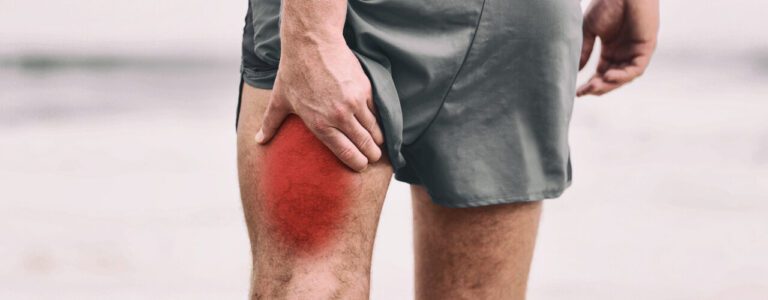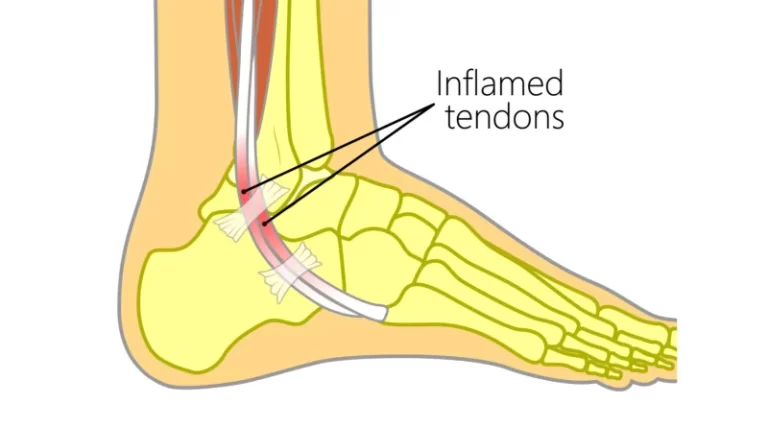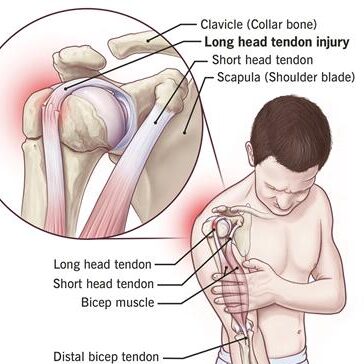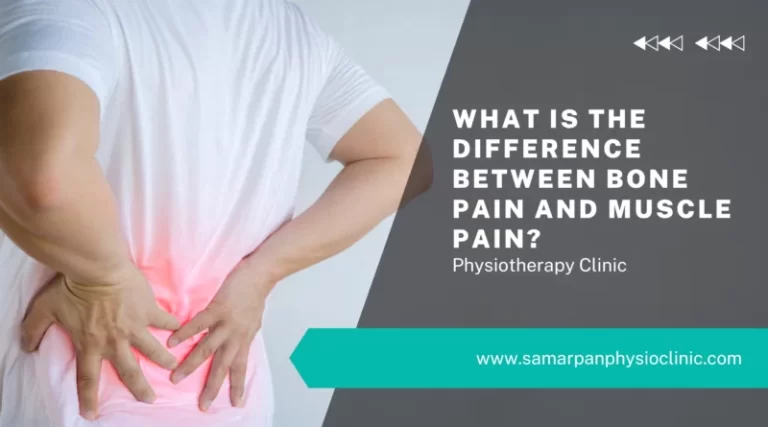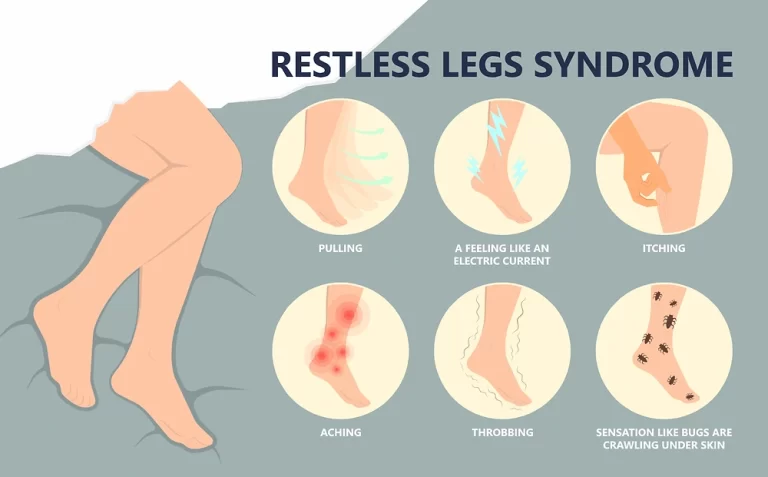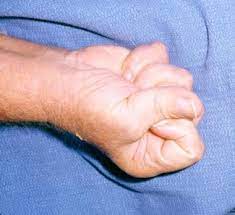Gracilis muscle pain
Table of Contents
What is the Gracilis muscle pain?
- Gracilis muscle pain is discomfort that occurs where the inside of the upper thigh & the abdomen come together. It’s not the same as pain in the testicles, though that can sometimes cause pain that can spread to the groin.
- Gracilis pain may vary in how it is experienced, however, & there are other groin pain causes apart from muscle injury. Diagnosis & treatment will depend on the symptoms & underlying cause, as well as whether the pain affects a child or adult, or males or females
Anatomy of the Gracilis muscle
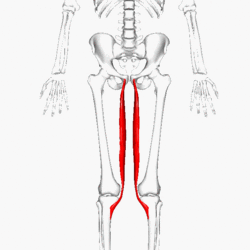
Origin: The gracilis muscle originates from the inferior ischiopubic ramus, & body of the pubis.
Insertion: The gracilis muscle descends almost vertically down the leg & inserts on the medial tibia at the pes anserinus. The pes anserinus is further the attachment site of the Sartorius & the Semitendinosus.
Nerve supply: The gracilis muscles are supplied by the anterior branch of the obturator nerve (L2-L4). The anterior branch of the obturator nerve is supplied by the adductor longus, & sometimes the adductor Brevis.
Blood supply: Gracilis muscle receives the majority of its vascular supply from the ‘artery to the adductors’, which is a branch of the deep femoral artery. The ‘artery to the adductors’ enters the gracilis via its lateral surface, approximately one-third away from its origin. The proximal part of the muscle also receives a small proportion of blood supply from the medial circumflex femoral artery and the distal third of the gracilis muscle is also to be supplied by a minor branch of the femoral artery.
Action: Gracilis acts on the hip & knee joints, resulting in several movements:
Strong leg flexion & the medial (internal) rotation around the knee joint when the knee is in a semi-flexed position.
Weak thigh flexion & the adduction around the hip joint, simply aid the other, more powerful thigh adductors.
Common causes of Gracilis muscle pain
- If your Gracilis muscle pain is especially painful when you walk, there’s a good chance it might be due to an injury to a muscle or the cartilage that connects the bones in your hip joints.
- Gracilis muscle pain that feels worse when you walk could also be caused by conditions that affect the organs & tissues within the abdomen & groin.
- The most common cause of gracilis pain is a muscle, tendon, or ligament strain, particularly in athletes who play sports such as hockey, soccer & football. Groin pain might occur immediately after an injury, or pain might come on gradually over a period of weeks or even months. Groin pain might be worsened by continued use of the injured part.
- Less commonly, a bone injury or fracture, a hernia, or even kidney stones might cause gracilis pain. Although testicle pain & groin pain are different, a testicle condition can sometimes cause pain that spreads to the groin area.
Direct & indirect causes of gracilis pain can include:
- Avascular necrosis or osteonecrosis death of bone tissue due to limited blood flow
- 2. Avulsion fracture
3. Bursitis joint inflammation
4.. Hip labral tear
- The hip labrum is the semicontinuous rim of cartilage that lines the outside of the hip joint socket. It acts as a cushion & also seals the joint & helps hold the ball of the thighbone inside the hip socket.
- An injury to the hip or degeneration over time can cause a hip labral tear. Some people may not have any pain & discomfort, but others may notice:
- pain in the hip & groin that gets worse if you walk or if you sit or stand for extended periods of time
- stiffness in the hip part & limited range of motion
- a clicking or locking feeling in the hip joint
5. Epididymitis: Epididymitis causes inflammation of one or both of the testicles. Epididymitis causes pain in the affected testicles, which can radiate up to the groin & the lower abdomen.
6. Hip impingement
- When the ball & socket don’t fit & move together smoothly in the hip joint, it can lead to a painful condition called hip impingement. It’s also known as femoroacetabular impingement.
- Hip impingement can be caused by a deformity in the ball at the top of the femur, also known as the thighbone. If the ball is misshapen, it can jam in the hip socket, especially when the bend over.
- This condition can also be caused by a hip socket that is not shaped properly or has an extra bone. This can prevent the ball of the femur from gliding smoothly inside the hip socket. In become, this can wear down the cartilage that lines the socket.
- Hip impingement issues can cause pain & stiffness in the groin part, especially when the walk or bend forward at the hip. It can also lead to osteoarthritis.
7. Hydrocele (fluid buildup that causes swelling of the scrotum)
8. Inguinal hernia
- An inguinal hernia is a type of hernia that happen near the groin area. It develops when tissue, such as the intestine or fatty tissue from the abdominal cavity, pushes forward through a weak section in the abdominal wall.
- An inguinal hernia can cause groin pain that worsens when the walk, bend, lift, or cough. Other symptoms include:
- a bulge in the groin part that gets bigger when you stand up or cough
- a feeling of heaviness or discomfort in the groin part
- Redness or sudden pain near the bulge
- Nausea, vomiting, fever
- swollen scrotum
9. Kidney stones: Kidney stones are constructed up of hard, crystal-like stones that are formed from mineral deposits. These stones often don’t cause symptoms until they move to where the kidney meets the ureter & beyond. Pain, which can be intense, may be felt on one side of the abdomen or low back. The pain can further radiate to the groin.
10. Mumps
11. Gracilis strain
- Gracilis strain is an injury to the muscle-tendon unit that make pain on palpation of the adductor tendons or its insertion on the pubic bone & pain in the adductor area on resistance testing of the adductors. Gracilis muscle strains are encountered more generally in ice hockey & soccer.
- These sports require a muscular eccentric contraction of the Gracilismusculature during competition & practice. The underlying injury is most generally a muscle or tendon strain at the insertion of the tendon of the Gracilis muscle to the bone. The Gracilis muscle is most frequently injured.
- Other symptoms of Gracilis strain include:
- reduced strength in the upper leg
- bruising near the affected muscle
- swelling
12. Orchitis (inflamed testicle)
13. Osteoarthritis
- Wear & tear in the joints, including the hip, can cause the cartilage to wear away over time, leading to osteoarthritis. When the cartilage has significantly worn away, the ends of the bones within a joint no longer move smoothly. Instead, they rub together, causing pain & stiffness.
- With hip arthritis, pain & stiffness are typically felt in the hip & groin parts. It can feel worse when they walk, stand, or climb stairs. The pain may feel good if you are resting.
- Another symptom may notice is a grinding or clicking sound or feeling in the hip when you move. You may also feel referred pain over the lower thigh & knee on the same side of the body as the affected hip.
14. Pinched nerve
15. Piriformis syndrome
16. Tendinitis
- Tendons attach the muscles to the bones. When these thick cords become irritated & inflamed, it’s known as tendinitis.
- It can develop in any tendon, & the pain usually starts off as a dull ache around the affected part. It’s more common in the shoulder, knee, elbow, or wrist, but can develop in the hip or groin part, too.
- Tendinitis is most often caused by repeated movements, like bending, throwing, turning, or kicking a ball. You’re at a higher risk if you tend to do the same motions on a regular basis while playing a sport, working out, or performing the job.
- With hip tendinitis, the pain usually has a gradual onset. It tends to get worse if you walk or do some activity & feels better when you rest. The affected part may feel tender to the touch, & you may also notice some swelling.
17. Urinary tract infection (UTI): A UTI is a bacterial infection that can produce anywhere in the urinary tract. It’s more general in women. Besides groin pain, symptoms can include pain or burning while urinating, & a change in the frequency or urgency of urination.
18. Strained round ligament: Located between the uterus & the front of the groin, the round ligament moves & changes shape as you walk. During pregnancy, it stretches to accommodate the expanding uterus, & can become strained & painful when you walk.
19. Retractile testicle (a testicle that moves between the scrotum & abdomen)
20. Sciatica
21. Scrotal masses
22. Ovarian cyst.: An ovarian cyst is a fluid-filled sac that can produce on one or both ovaries. Most of the time they are painless, but symptoms can appear if the cyst grows. Symptoms can consist of groin or lower back pain, abdominal bloating, & painful bowel movements.
23. Testicular cancer: Many times, this cancer causes a painless lump in or on the testicle. But sometimes, it’s painful. It’s not common cancer. If it’s established early, it’s almost always treated & cured.
24. Prostatitis: This is swelling or infection in the prostate gland. In addition to pain, you may have a hard time peeing.
See your doctor. Prostatitis can occasionally go away on its own. But if it’s caused by an infection, you may require to take antibiotics.
This pain is lead to gracilis muscle strain & gracilis muscle pull.
This gracilis muscle strain is present in 3 degrees of strain.
Grade 1: no loss of function or strength. Muscle tears can show normal appearances or a small part of focal disruption (<5% of the muscle volume), with hematoma & perifascial fluid relatively general on imaging with US & MRI.
Grade 2: severe, with some weakness. Injury corresponds to a partial tear, with muscle fiber disruption seen (>5% of the muscle volume) but not affecting the whole muscle belly. In acute grade 1 or 2 strains of the adductor muscle, there is intense pain in the groin part, like a sudden stab with a knife, if the athlete attempts to continue the activity. Generally, a hemorrhage & swelling can be seen a few days after the injury. A typical trauma history, localized tenderness & difficulties contracting the hip abductors.
Grade 3: complete muscle tear & total functional loss. Injuries are complete muscle tears with frayed margins & bunching and/or retraction of the torn muscle fibers. Complete muscle tears or grade 3 strains are most often found in the distal musculotendinous junction located toward the insertion of the femur.
What are the usual symptoms of gracilis muscle pain?
- People with gracilis muscle pain usually experience pain high in the groin area, within the upper 1/3 of the gracilis muscle region. If the pain is long-standing, however, the painful part may become less localized to the initial area of injury or pain. It can extend across the pubic region & into the lower abdomen. Sometimes it can also spread to the gracilis region in the opposite leg.
- Subsequent an acute adductor injury pain may be experienced when:
- Walking
- Standing on one leg
- Turning or diverse the direction while standing on the injured leg
- Lifting the leg to dress or move in & out of the car
- Coughing or sneezing
- Increased pain with touch
If the pain is milder or has been around quite a while, there is usually little or no pain at rest or during normal low-level daily activities. Pain will usually happen during more strenuous or dynamic tasks such as:
- Running, especially when accelerating or decelerating
- Kicking
- Hopping
- Bounding
- Deep split lunges or side lunges
- Athletes with gracilis pain are often able to continue or return to their sport after the acute injury settles, but they may struggle to reach full speed & sporting performance due to pain or reduced power.
In which condition do you need to contact the doctor?
- If you feel severe pain & swelling in the groin area.
- If changes the color of the groin & upper thigh
- If you feel a tingling, weakness & numbness in the groin area & leg.
- If You cannot move the leg.
- If You cannot put the weight on the leg.
How to Diagnose gracilis muscle pain?
- Most cases of gracilis muscle pain do not require medical attention. However, you might see a doctor if you experience severe, prolonged pain accompanied by fever or swelling. These symptoms indicate a serious problem.
- Because gracilis muscle pain can have many possible causes, your healthcare provider could diagnose the condition in a number of different ways.
- The doctor will evaluate the symptoms & ask about any recent physical activity. This information will help the doctor diagnose the condition. They will then perform a physical examination of the groin part along with other tests, if necessary.
- Your healthcare provider will ask about the medical history & other details about the gracilis pain, such as:
When it started:
- Whether you experienced an injury
- What makes the pain worse & better
- Whether you have any other symptoms
- You will usually need a physical exam. You may also require imaging tests to confirm the diagnosis.
Physical Examination
Throughout the physical exam, the doctor will perform:
- An abdominal exam
- If he were born male, a testicular exam
- A neurological exam
- A musculoskeletal exam focusing on the hip
- People with hip joint problems also have discomfort while bending & rotating the hip joint. An example of this type of motion is when you sit down & rest the ankle on the thigh.
Hernia test
Your doctor will insert one finger into the scrotum (the sac that contains the testicles) & ask you to cough. Coughing raises the pressure in the abdomen & pushes the intestines into the hernia opening.
A gracilis muscle strain can be diagnosed by the physical exam alone. Other causes of groin pain usually need imaging, though.
X-ray: X-rays can help the healthcare provider see if a bone fracture is causing the gracilis pain. X-ray is commonly used to diagnose gracilis pain. This imaging test captures photos of internal structures in the body. In this case, the X-ray can show the bony anatomy & structure of the hip joint.
X-rays are the best way to see the area of cartilage damage. They can also show other signs of hip osteoarthritis, like bone spurs & joint space narrowing.
If your groin pain appears to be related to the testicles or an inguinal hernia, The healthcare provider may order an ultrasound. Ultrasounds use sound waves to create an image of the body’s internal structures.
If a kidney stone is a potential culprit, the healthcare provider may opt for a computed tomography (CT) scan. A CT captures multiple X-rays & combines them to form a three-dimensional image.
Ultrasounds & CT scans of the abdomen & pelvis can also diagnose intestinal problems or other conditions of the abdomen & pelvis.
A magnetic resonance imaging (MRI) test is also used to look at the soft tissue around the hip joint. An MRI uses a magnetic field & radio waves to create images of the internal body structures. MRIs can show muscles, tendons, ligaments, & labrum.
Sometimes an MRI is performed with contrast. During this procedure, you will sustain an injection of a special type of dye. This helps subtle injuries of the cartilage & labrum inside the joint show up better on the scan.
An MRI can often be used to look for nerve problems. For example, a pinched nerve in the back can sometimes refer pain to in the groin. This means may feel like the pain is coming from the groin even though the injury is elsewhere.
In a case like this, an MRI can help to find the true source of the pain.
Complete blood count (CBC): This type of blood test can help to determine if an infection is present.
Differential Diagnosis
- Traditionally, gracilis pain has been thought to be complex with various definitions & terminologies without any diagnostic criteria. In a systematic review on the treatment of groin pain in athletes, more than 30 different diagnostic terminologies were used to describe gracilis pain which adds up to the complexity of groin strain in athletes.
- A classification system of groin pain was described in 3 main subheadings during the Doha agreement meeting;
Defined Entities.
- Adductor-related groin pain
- Iliopsoas-related groin pain
- Inguinal-related groin pain
- Pubic-related groin pain
- Hip-related groin pain
Other musculoskeletal causes.
- Inguinal or femoral hernia
- Posthernioplasty pain
- Nerve entrapment
- Obturator
- Ilioinguinal
- Genitofemoral
- Iliohypogastric
- referred pain
- Lumbar spine
- Sacroiliac joint
- Apophysitis or avulsion fracture
- Anterior superior iliac spine
- Anterior inferior iliac spine
- Pubic bone
- Referred pain
Not to be missed.
- Stress fracture
- Neck of femur
- Pubic ramus
- Acetabulum
- Hip joint
- Slipped capital femoral epiphysis (adolescents)
- Perthes’ disease (children and adolescents)
- Avascular necrosis or transient osteoporosis of the head of the femur
- Arthritis of the hip joint
- Inguinal lymphadenopathy Intra-abdominal abnormality
- Prostatitis
- Urinary tract infections
- Kidney stone
- Appendicitis
- Diverticulitis
- Gynecological conditions Spondyloarthropathies
- Ankylosing spondylitis Tumours
- Testicular tumors
- Bone tumors
- Prostate cancer
- Urinary tract cancer, Digestive tract cancer, Soft tissue tumors

What is the Treatment of gracilis muscle pain?
RICE Principle
The starting phase of pain relief is used to the RICE principle.
R – rest = When the pain is occur avoid movements that are produced to further injury & pain. so that does the rest for some time or do the minimize activities in which the adductor longus muscle is used like as walking &running activities.
I – ice = Ice is applied to the area of pain for 20 minutes and released to pain & swellings. you can also use ice packs & frozen peas.
C – compression = Applied to compression bandage to release the swelling & spasms.
E – elevation= Patient is elevated to the affected leg with the help of a pillow to release the swelling.
- Non-operative therapy should be tried for several months & is successful in most instances. However, if symptoms & significant restriction of performance persist after an appropriate conservative treatment regimen, surgical intervention might be considered. Adductor tenotomy has been suggested as a technique to improve symptoms.
- In a recent systematic review that compared surgical intervention to conservative intervention, there was a faster return to return to play(RTP) time in athletes who had surgical intervention. However, the varied nature of surgical interventions & lack of quality randomized control trial (RCT) in the meta-analysis makes it impractical to recommend the surgical intervention.
Medical treatment :
- When the patient feels muscle pain, the patient can be used pain relief drugs such as
- Nonsteroidal anti-inflammatory drugs = NSAIDs including to ibuprofen / naproxen.
- The patient can also be used pain reliever gel or patches such as volini gel & diclofenac gel & on the area of muscle pain to reduce the pain.
Heating therapy :
- After 2 – 3 days of muscle pain when the swelling is gone, apply heat with the help of putting the warm water bottle & a heating pad till the patient feels comfortable in the groin area.
- But always take care of this thing Do not go to sleep with the heating pad on the skin, because it occurs to burns.
Grcilis strain treatment:
- Gracilis strain treatment depends on the grade.
- In the Initially phase, pain management of groin strain is usually used with acetaminophen & non-steroidal anti-inflammatory medications.
- You can also be used the RICE principle for pain relief.
- From mild to more severe strain which is take to time ranging from 3 weeks to 6 weeks of rest & even longer time to heal.
- When occur A complete tear means 3 degree of strain which requires surgery & take to up a three-month recovery period.
When gracilis pain is an emergency
See a doctor without delay if you’ve:
- Sudden onset, & severe pain
- Nausea, vomiting,& fever, or chills with the pain
- Severe testicular pain that radiates to the groin
- Problems urinating, including blood in the urine
Surgery: Surgery can address more severe muscle tears & bone breaks or other problems like a hernia that may be the source of the discomfort.
What is Physiotherapy treatment for gracilis muscle pain?
The physiotherapy treatment includes electrotherapy, stretching & exercise to release the muscle pain.
Electrotherapy for the gracilis muscle pain:
- This electrotherapy treatment includes SWD, TENS, IFT, and the US machine which is used to reduce pain & swelling.
- Ultrasound therapy = US machine is used on the tender points & trigger points to reduce the swelling.
- Short wave diathermy = SWD is applied to an area of muscle pain to reduce the pain.
- TENS & IFT machine is used in the area of muscle pain to release the pain & swelling.
- For gracilis pain relive the patient begins with electrotherapy modalities as once a pain; subsides begin with light exercise, once a patient achieves normal strength then begin with more strenuous & strengthening exercises.
Gracilis muscle stretching exercise
- The gracilis involve the inner leg muscles called the groin. The Gracilis muscle stretch will include the group of muscles that has a significantly large muscle mass. The key action of these muscles is to pull the leg inward. There is more useful for them in sports such as soccer, where these muscles are used in kicking a soccer ball with the inside of the foot. Finally, they are utilized in flexion & extension of the thigh when against resistance or running.
- Lunge Stretch
- Standing Lateral Lunge gracilis Stretch
- Butterfly Stretch
- Half-kneeling adductor dips
- Supine Wall Stretch
- Standing Gracilis Stretch
- Kneeling Gracilis stretch
- Gracilis AIS Release
- Frogger stretch
- Lateral squat
- Crossover stretch
- Seated Gracilis Stretch
- Reclining angle bound pose
- Standing banded adduction
- Hip Opener and Groin Stretch
- Runner’s Lunge
- Squatting Groin Stretch
- Frog Squat With Arm Raise
- Lunge Stretch

How to perform stretch:
- Begin kneeling on the ground in a lunge position.
- Bend your torso forward to bring the outside of the shoulder towards the interior of the lead knee.
- Then, lunge forward so the hips slide forward.
- You can feel a stretch along the inside of the forwarding leg.
- Hold this adductor stretch for 5- 10 seconds then release.
- Perform 10-12 repetitions.
2. Standing Lateral Lunge Gracilis Stretch
How to perform stretch:
- Stand in a broad stance position.
- Now bend your & knee & move your hips to that side.
- maintain posterior pelvic tilt during the stretch
- You can feel the stretch inside of the opposite thigh.
- Hold for 5-10 seconds & release.
- You can enhance holding time in progression.
- Do this adductor stretch 4-5 times.
3. Butterfly Stretch

How to perform stretch:
- Sit down on the ground with your legs in front of you.
- Reach forward & grab your left foot.
- You can bend the knee to help the hand & foot join.
- Slowly pull your left foot up towards the groin bending until it is at a comfortable place & the sole is facing your right thigh.
- Bend your right knee to bring your right foot toward the groin so that it is sole touches the sole of your left foot.
- Hold both feet with your hands & place your elbows on the knees.
- While maintaining the back straight, allow your knees to fall towards the ground.
- You can give gentle pressure to the inner thigh by pressing gradually on the knees with the elbows.
- You might feel pulling & tension in your groin.
- Hold the butterfly stretch for 20-30 seconds.
- Release & repeat 2-3 times.
4. Half-kneeling adductor dips
How to perform stretch:
- Half-kneeling adductor dips
- Start in a half-kneeling position with the right knee on the floor & the left leg bent with the foot on the floor.
- Move the left leg out to the side as much as you can.
- Your foot might be at a right angle to your knee.
- With your hands on your hips, dip the body toward the left leg.
- You can feel the stretch on the inner thigh—especially on the right side.
- Repeat 8-10 times.

5. Supine Wall Stretch
How to perform stretch:
- In the supine position in front of a wall with the leg up on the wall.
- move towards the wall as you can, and maintain the comfortable stretch in the hamstrings.
- Maintain the leg straight while they slowly split open until you feel a stretch inner side of the legs.
- Hold the stretch for 15-30 seconds.
- Relax & repeat 3 times.
6. Standing Gracilis Stretch
How to perform stretch:
- Start standing with the feet around 3 feet apart.
- Transfer the weight to one side & bend your knee.
- Keep the other knee straight to feel a stretch on the inside of the thigh.
- Hold the stretch for 15-30 seconds.
- Relax & repeat on the other side.

7. Kneeling Gracilis stretch
How to perform stretch:
- Begin with your knees & hands on the ground.
- Straighten out a left leg to the side. Try to keep the leg on the floor.
- Move your butt back to the heel of your right bent knee.
- You can feel the stretch on the inner thigh of the left leg.
- Pause for 8-10 seconds, then release the stretch & back in.
- Repeat 8-10 times.
8. Gracilis AIS Release

How to perform stretch:
- Begin in a supine position with a resistance strap on around one foot.
- The opposite end of the strap is grasped in the hand.
- Then, actively slide the foot sideways.
- make sure to slide the foot, don’t raise it or the hip flexors can contract.
- At the end of the movement gradually pull the foot further outwards with the resistance strap.
- You can feel a stretch in the adductors.
- Hold the stretch for 5 to 10 seconds then slide to return.
- Perform 8-10 repetitions.

9. Frogger stretch
How to perform stretch:
- Start with your knees & forearms on the ground with your knees & feet wider.
- Try to keep the inner part of your feet on the floor.
- Sit the butt back to the heels, feeling the stretch on the inner thighs.
- Pause for 10-15 seconds, then release the stretch & back in.
- Repeat 8-10 times.
10. Lateral squat
How to perform stretch:
- Stand tall & put the feet double shoulder-width apart.
- Transfer your weight to your left leg, bend your left knee, & push your hips back as if you are taking a sitting position.
- Drop as low as possible while keeping your right leg straight.
- Keep the chest up & your weight on the left leg.
- Breathe & hold for 15 to 20 seconds prior to returning to the beginning position.
- Repeat 2-3 times, then move to the other side.
11. Crossover Stretch
If you love dancing, this move might come naturally as it is the same as the “grapevine” dance move.
How to perform stretch:
- Start with the feet together, then step to the right with the right foot.
- Cross your both foot.
- Step to the right again with your right foot, & bring your left foot to join your right foot.
- Once both the feet are together and repeat on the opposite side.
- You can start gradually, but pick up the stride as you get used to the move.
- Do it 5-10 times.
12. Seated Gracilis Stretch
How to perform stretch:
- Straight the legs out to the side, and make a “V” shape.
- To prevent joint strain, do not overdo this pose.
- For many people, simply sitting like this is enough to give an inner thigh stretch.
- If you want to feel more stretch, keep your back straight, and lean towards the floor from your hip joints.
- Stay there for around 10-15 seconds. breathe normally.
13. Reclining angle bound pose
This is the best stretch if you spend most of the day in a sitting position.
How to perform stretch:
- Take a supine position on the ground.
- Bend both knees & draw your soles inward so that their borders are touching each other.
- Move the knees down toward the floor so that you can feel the groin muscles stretching.
- Breathe & hold this position for 15- 30 seconds.
- Repeat 3-4 times. Try to draw the feet closer to the buttocks with every stretch.
14. Squatting Groin Stretch
How to perform stretch:
- Take a standing position with the feet wide apart, toes pointing outwards.
- Slowly start squatting down until your knees are directly over the ankles & bend to 90 degrees.
- Put your hands on top of your inner thighs & gently push outward to open the hips.
- You will feel a stretch in the inner side of each leg.
- Hold for 20 – 30 seconds, relax & repeat 3 times.
15. Hip Opener and Groin Stretch
How to perform stretch:
- Begin in a forward lunge position & drop your right knee to the floor.
- Place the left elbow on the inside of your left knee as pictured.
- Press the left elbow gently into your left knee & twist your torso to the right.
- Reach the right arm behind you until you feel a gentle stretch in the lower back & left groin.
- Hold the stretch for about 20-30 seconds, release & repeat on the right leg.
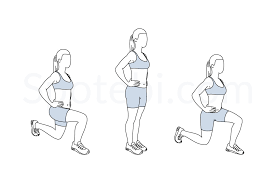
16. Runner’s Lunge
How to perform stretch:
- Get on all fours, facing the front of the mat.
- Plant the fingertips gently into the floor as you extend your right leg behind you, maintaining the knee rested or lifted slightly.
- Press the right heel toward the back of the room.
- Bring the left foot forward so it is in line with your left hand.
- Maintain your head upwards.
- Inhale & exhale, driving the hips further into the ground with each breath.
- Then, move to the other sides.
17. Squatting Groin Stretch
How to perform stretch:
- Take a standing position with the feet wide apart, toes pointing outwards.
- Slowly start squatting down until your knees are directly over the ankles & bend to 90 degrees.
- Put your hands on top of your inner thighs & gently push outward to open the hips.
- You will feel the stretch in the inner side of each leg.
- Hold for 20 – 30 seconds, relax & repeat 3 times.
18. Frog Squat With Arm Raise
How to perform stretch:
- Moving directly from the first stretch, place the right hand on the ground.
- Continue to gradually push your inner thigh outward, as you reach the left hand directly up to the roof, fingers pointed upward.
- With each breath, twist the upper body slightly further, reaching as high as you can.
- Your right heel might lift slightly.
- Then, switch the other sides.
Gracilis muscle Strengthening Exercises.
- Gracilis muscle exercises utilize multiple small muscles in the inner thigh that are responsible for bringing the thighs together, providing balance & support, and proper hip alignment. Most people should only consider doing hip adductor exercises whenever they walk past the hip adductor machine in the gym but we are here to change that Mentality.
- It is essential to strengthening the gracilis muscles to increase mobility & flexibility, enhance stability & prevent leg injuries. Strong abductors are an integral part of sports performance, maintaining mobility, & injury prevention, as you age. This is the main muscle group that contributes to hip mobility & strength. In terms of strength training, the adductors are mostly overlooked because they can be difficult to train properly.
- Standing Leg Circles
- Side-Lying Hip Adduction
- Squat Side Kick
- Standing side Leg Raise
- Sumo Squat
- Cross Scissors
- Dumbbell Side Lunge
- . Cossack Squat
- Copenhagen Side Plank
- Cable Hip Adductor
- Seated Hip Adduction
- Adductor machine
- Wide stance squat
- Standing banded adduction
- Seated banded adduction
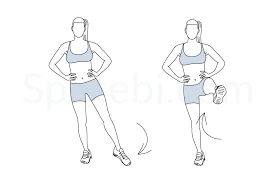
- Standing Leg Circles
How to do it?
- This is the dynamic warm-up exercise, this exercise improves blood circulation to the hip muscle & upper leg.
- for standing leg circle exercise, stand with feet hip-width apart.
- Raise the left leg off the floor. while balancing on the right leg, make a small circle with your left leg.
- Complete 10 to 20 repetitions on the left side then change to the right leg.
- Note: If you have a balance problem, stand close to a prop where you can help maintain your body by holding something.

2. Side-Lying Hip Adduction
How to do it?
- This is the best exercise for the hip adductors that can be done on the ground while isolating a single leg at a time.
- All you need to do is to focus on contracting the hip adductor muscles to raise your leg off the floor.
- For this exercise, you have to lie down on your left side and take your arms in front of you with your elbows & forearm on the floor for support. raise the right leg over your lower leg placing your heels against the thigh of your bottom leg.
- maintain your leg extended, and raise it upward as much as possible.
- Slowly return to the starting position.
- Do 10-25 repetitions on the left side then move to the right leg.
- Note: You can add some provocation to your exercise by using a resistance band attached to an anchor or by strapping an ankle weight to the leg.

3. Squat Side Kick
How to do it?
- The squat side kick bodyweight exercise will utilize both the adductors & the abductors & is a great all-around lower limb exercise.
- This exercise combines 2 movements that enable both muscle strengthening & stretching which is important to decrease the risk of suffering from groin pain.
- For the Squat Side Kick exercise, you have to stand with a shoulder hip-width apart, and your hands are together in front of you.
- Flexed your knees until your thighs are parallel to the floor, then stand up & transfer your weight to your right leg while kicking out the left leg to the side.
- Back to squatting position then repeat it on another leg.
- Note: Your core muscles might be engaged throughout the movement with your back straight, chest up, & do not let your knees extend past your toes while squatting.

4. Standing side Leg Raise
How to do it?
- This is the best bodyweight exercise that can hit the hip adductors of one leg while hitting the hip abductors of the other leg as
- you will be using an isometric hold on your other leg to maintain it in the air.
- For this exercise, you have to stand with shoulders hip-width apart. now on the left leg away from the body.
- Then Lift the right leg as far as comfortable, & hold it there for 4-6 seconds.
- Raise your left leg to your right leg until they touch then lower back to the starting position. Complete 10-18 repetitions of 2-3 sets.
- Note: To make this exercise more challenging strap ankle weights to both legs.
5. Sumo Squat
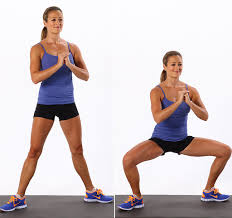
How to do it?
- This variation of the squatting will hit the muscle groups in the lower limb plus the inner thighs.
- Maintain your back straight & your chest up throughout the exercise.
- Even though the sumo squat has a smaller range of motion compared with a regular squat, it is still an effective exercise that can be incorporated into normal workouts.
- For this exercise, you must stand wider than the shoulder-width stance with your pointing outside.
- Take a squatting position, drop your hip down & back while your back is straight & chest up until your thighs are parallel to the ground.
- Push off through the ground and return to the starting position.
- Note: If you want to add some provocation to your exercise, hold a kettlebell in your hand.
6. Cross Scissors
How to do it?
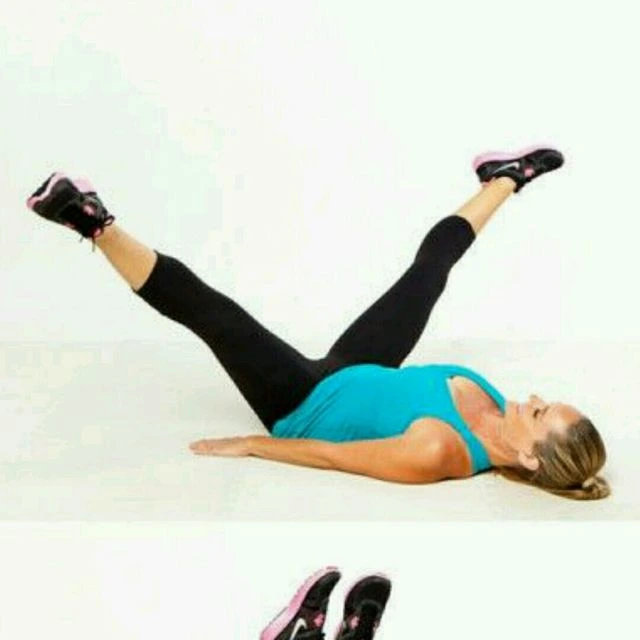
- This is the best exercise to work hip adductor muscles & the core muscle simultaneously.
- Cross scissors are challenging as you require to stay in a crunched position throughout the movement.
- Maintain this position by crossing your legs in front of you need all your stabilizing muscles to be contracted.
- For this exercise, you have to Sit down & brace yourself by putting your hands on the floor back to you. move your leg off the ground in front of you at a 30-40-degree angle with one leg crossed over the other.
- Your core muscle might be engaged throughout the movement in a semi-“V” position change your legs out to the sides then bring them back closed while crossing the other leg over.
- Do this with an Alternate leg until you complete 10-20 repetitions on each side.
- Note: You can enhance the difficulty of cross scissors by sitting in a “V” position without bracing the upper limb with your arms.
7. Dumbbell Side Lunge
How to do it?
- The side lunge is an excellent exercise to improve your balance, stability, & lower limb strength.
- The side-to-side movement is both a strengthening & stretching exercise. Dumbbell Side Lunge exercise utilizes your hip abductors & hip adductor muscles.
- For this exercise, you have to stand with shoulder hip-width apart & hold the dumbbells at your chest level.
- Take a large step to your side & drop your hip down & back until your thighs are parallel to the floor while your foot is planted on the ground.
- Push through your flexed foot, & bring your back to the initial position.
- Repeat it for 10-15 repetitions then move to the next leg.
- Note: To make this exercise easy you can do bodyweight side lunges. your back might be in a neutral position & chest up while trying not to lean forward.
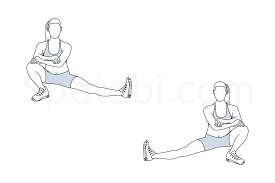
8. Cossack Squat
How to do it?
- Cossack Squat exercise moves the body through the frontal plane of motion, going side to side.
- Working lower limb at this angle can improve the flexibility of hips, knees, & ankles.
- You will increase your stability by mastering this exercise by getting a good stretch & strengthening the hip adductors.
- For this exercise, you have to stand with feet in a wide stance with toes pointing outside by dropping your hips downward & back.
- Squat down to that single side and shift your weight while your other leg is extended out with your heels on the floor, toes pointing up.
- Push through the ground with your flexed leg and bring your back to starting position.
- Repeat this exercise on the other leg by shifting the weight & lowering it down into a squat position on the other side.
- Note: Cossack Squat exercise requires a high degree of mobility so if you can not go all the way down then go as far as you can while trying to improve each workout. your back might be maintained in a neutral position throughout the exercise.
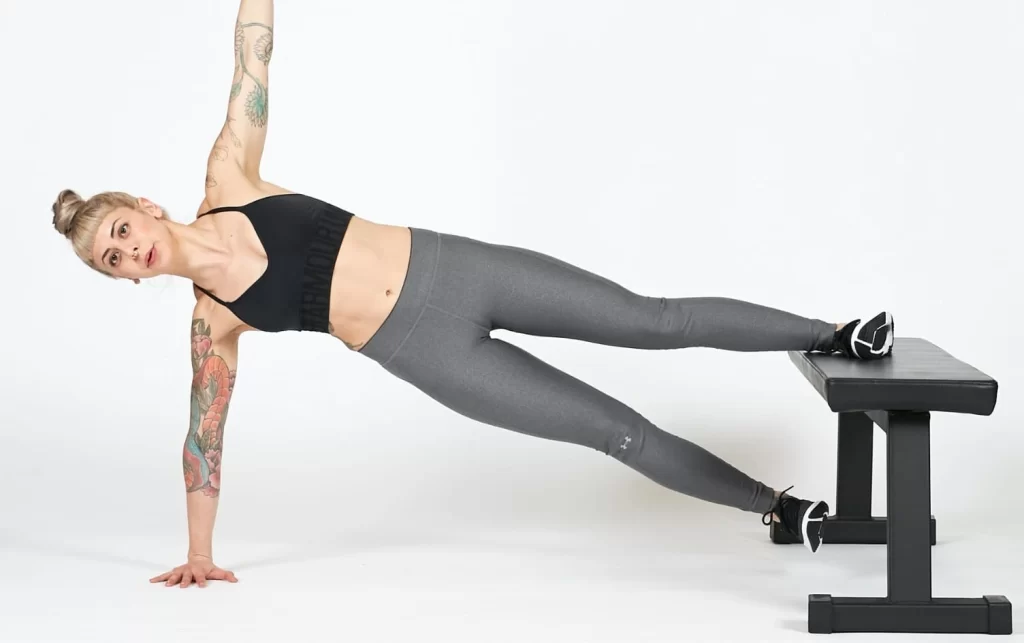
9. Copenhagen Side Plank
How to do it?
- Copenhagen Side Plank exercise is the most difficult variation of plank that not only hits the core muscles but also strengthens the hip adductors. Copenhagen Side Plank exercise will help to balance out the strength in the muscles on the outside of the hip.
- For this exercise, you have to lie down on the floor & perpendicular to the bench then brace yourself on your forearm & elbows.
- Lift with your flexed knee lift your top leg & place it on the bench.
- Hold this position.
- Complete 20-25 repetitions for 2 sets then do this on another side.
- Note: Increase the difficulty by doing this exercise with legs extended with only your ankle placed on the bench.
10. Cable Hip Adductor
How to do it?

- You may notice women at the gym doing this exercise while the men neglect it.
- It is time to move the stigma that cable hip adductions are not mainly, everyone might be doing this exercise to strengthen the adductors to reduce the risk of injury.
- Make sure you are warmed up with some dynamic stretches before performing this exercise then try to start with less weight & maximum repetitions until you are comfortable enough to increase the weight.
- Find an attachment that you can use to strap onto the ankle closest to the pulley.
- Set up the pulley around calve level. Stand to the side of the pulley. Brace yourself using your hand against the machine in a safe place where your fingers won’t get pinched. Your active leg might be up off the floor towards the pulley.
- Pull your leg away from the pulley towards the middle of your body.
- Slowly let leg return to its starting position Completed the desired number of repetitions
- Note: exercise can also be done with this same technique by attaching a resistance band to a fixed anchor point.
11. Seated Hip Adduction
- The seated hip adduction will isolate the hip adductor muscles when you are seated, only having to focus on bringing thighs together.
- Add Seated Hip Adduction exercise towards the end of your leg day after completing the bigger compound lifts such as squatting.
- Seat in the machine with back against the backrest
- Set the width of the knee pads to a manageable position that gives a stretch to the inner thighs but does not over-stretch the adductor muscles.
- Set up a lightweight for the 1st time set so that you do not overdo it.
- Squeeze thighs together while exhaling, until your knees meet in the center of the body.
- Slowly return to the initial position.
- Complete maximum repetitions.
12. Adductor machine
How to do it?
- Most people think of isolating the adductors, they may think of the classic adductor machine established in gyms across the world.
- Though this machine can do the best job of training the adductor, it is not the only movement that can yield good results.
- Considering that you can modify the amount of weight & width of the pads, this exercise is great for beginners. It is best to begin super light to get a feel for the exercise & avoid getting injured.
- For this exercise, you have to sit on the machine begin with sitting on the machine with the pads positioned between your legs as wide as is comfortable, & select your ability-wise resistance.
- In a controlled manner, contract thighs together just until the pads touch, & feeling the muscles contract.
- gradually reverse the movement, returning your thighs to the initial position. Repeat this exercise number of sets & repetitions.
- If just beginning, try 2–3 sets of 10 reps.
13. Wide stance squat
How to do it?
- Squatting is a king of leg exercises & this will stimulate the whole leg.
- There have different squat variations but here we discuss the wide stance squat also called sumo squat which will utilize inner thigh muscles.
- You can do this exercise with a variety of weighted equipment like a barbell, kettlebell, dumbbell, or sandbag — or with just only body weight.
- For the Wide stance squat exercise, you have to stand a little wider than the shoulder hip-width apart, and turn your toes outside.
- Shift your weight backward & slowly lower your hips until your thighs are parallel to the ground.
- Then return to the starting position by pushing through the ground, and your inner thigh muscles are contracted.
- Do 10-15 repetitions of 2-3 sets.
14. Standing banded adduction
How to do it?
- For this exercise, you need a resistance band, and wrap a resistance band on a solid anchor. you have to stand on either side of the body facing the anchor point & the resistance band.
- Allow the resistance band to pull the leg to the side by resisting the movement.
- To start this exercise you have to stand tall & bring a banded leg towards the midline of the body, you feel the good contraction in your inner thighs.
- Gradually release your leg back to the side with control movement.
- Switch the legs & do 10 to 20 repetitions for 3 to 4 sets on each leg.
15. Seated banded adduction
How to do it?
- For the Seated banded adduction exercise you need a resistance band, and wrap a resistance band on a solid anchor.
- You have to sit on the bench on either side of your body facing the anchor point & the resistance band.
- Put the internal foot through the resistance band, the band is positioned just below the knee joint. allow the resistance band to pull the leg towards the anchor point.
- Move your leg towards the center of the body by contracting the adductor muscle.
- Repeat this on each leg.
- Do 2-3 sets of 12-15 repetitions.
16. Lateral Lunge

How to do it?
- For the Lateral lunge exercise, you have to stand with feet hip-width apart. step out of your left leg & start with sending your hip back as you flex your left knee.
- You can extend your arms forward for counterbalance if you like. during the descent, the knee should not move more than 2 inches beyond your toes, &your knee should be aligned between 2 & 3 toes.
- The toe turns outwards slightly. push-off through left to return to a starting position.
- Repeat on the right side leg to complete the 1st repetitions.
- Do 3 to4 sets of 8 to 10 repetitions on each leg.
When did you not do this exercise?
- If your health care provider advised to you take a rest.
- If you are already suffering from back & knee pain.
- If your lower limb bone recently fractured.
- If you feel pain during this exercise.
How to prevent Gracilis muscle pain?
Gracilis strain can be painful, & can keep you away from activities you love. There are ways that you can help prevent gracilis pulls that result from strains:
- Warm up your legs & groin muscles before any physical activity. A light jog or other activities to get your body temperature up can lower the chances of muscle stains.
- Wear shoes that are comfortable for proper support.
- Raise the intensity of the training slowly.
- Stop exercising if you feel pain or tightness in the groin or the inside of the thigh.
- Do regular strengthening exercises for the thigh muscles, especially if you’ve had a groin pull before.
- Ask your doctor about other things you can do to make groin strain less likely.
- Subsequent Gracilis strains may happen, resulting in a recurrent problem. Hence primary & secondary prevention is equally important. To identify the athlete at risk & possibly correct the predisposing factor, the intrinsic & extrinsic risk factors for the injury type must be known.
- Previous Gracilis injuries, reduced hip adduction strength, higher level of play & lower levels of sports-specific training are associated with an increased risk of new groin injuries. Hölmich et al demonstrated that an 8 to 12-week active strengthening program, including progressive resistive adduction & abduction exercises, balance training, abdominal strengthening & skating movements on a slide board, was effective in treating chronic groin strains. Also, coordination exercises (focused on the muscles related to the pelvis), core stability exercises & eccentric exercises are a part of the prevention program.

